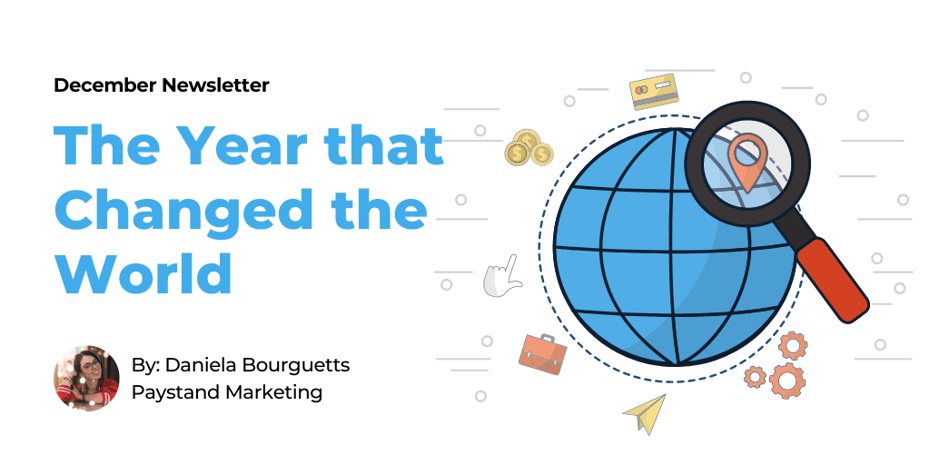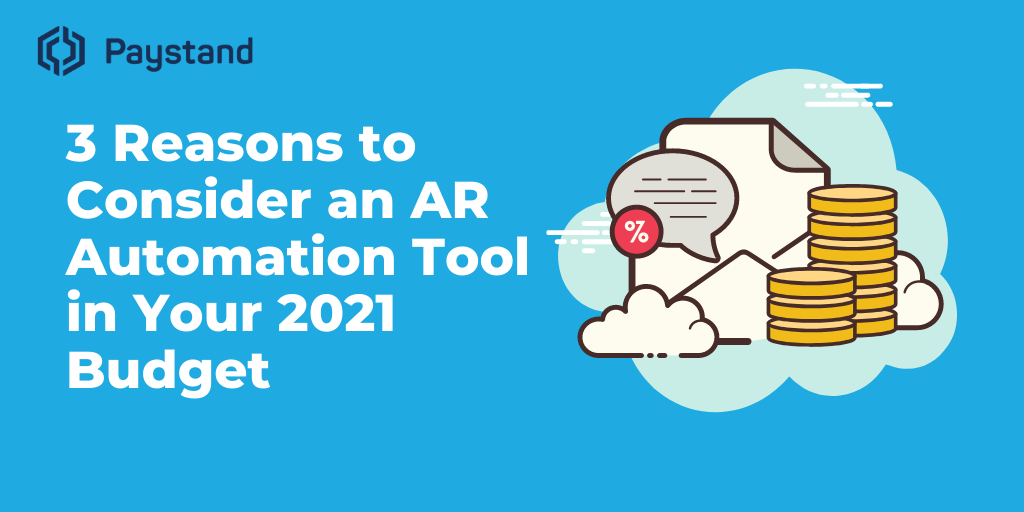Issue #09: The Year that Changed the World


Editor’s note: Hey there, my name is Daniela and I’m the editor of Paystand’s newsletter. Each month, I send a roundup of the best payments and finance content from Paystand and around the web, direct to your inbox. Don’t miss the next issue. Subscribe now.
What a year it's been! We witnessed almost every economic scenario possible as businesses changed their financial strategies to cope with unprecedented challenges. While some were able to embrace opportunities to improve their operations and thrive in the face of uncertainty, others were forced to cut back on staff and budgets to survive the recession. Initially, this difference had more to do with the random chance of how various industries were affected by the pandemic. But as the year wore on, the difference between thriving and just surviving had more to do with strategic choices and technology investments.
In finance specifically, 2020 illustrated that more and more businesses are relying on contactless payment alternatives for modernizing their financial operations. Virtual cards for B2B transactions are helping companies get better control of their expenses. Native platform payments are the next big step for owning the payment process, and paper-based methods are starting to see a decline in favor of digital alternatives.
While the effects of the COVID-19 pandemic are still shaping the state of the economy, we no longer have any doubt that businesses can strengthen their financial strategies for healthy cash flow, incentivizing team resiliency, and process automation in finance.
So, for our final newsletter of 2020, we pulled together the most important lessons we learned during the last year to give you a roadmap and a headstart on digital transformation in finance in 2021. From AR automation to B2B payment tendencies that can help your businesses get (and stay) ahead, read on.
- Lessons Learned from 2020
- Product updates
- Industry Articles
- Social Media
- Get A [Budget-Free] Head Start on 2021
Lessons Learned from 2020
In April, businesses were caught in an unexpected tempest, trying to survive under the pressure of the lock-down. Consumer payments platforms were in more demand than ever, as people started switching to digital methods to keep their families safe while restocking on daily needs. But the same could not be said for B2B transactions that were still largely made via slow, outdated paper checks and subject to inefficient, manual processes
- The Lesson: During these trying times, it was imperative for CFOs to answer this question: how can my business continue accepting payments and operate remotely? The solution is in our April Newsletter: Toucheless B2B Payments.
We took a deep dive into AR optimization for achieving a healthy cash flow in our May Newsletter. By 2021 we expect process automation to continue its rapid adoption since remote work isn't going anywhere, and the need for faster and leaner operations will keep rising.
- The Lesson: AR strategies need to change to keep in line with current demands for stable cash flow. Automation is one way to save time, money, and reduce DSO. ****
In the June newsletter, we made a case for automation as the cornerstone for financial teams. Amidst this panorama, payment platforms like Paystand make a difference for over 170K companies that continue to grow and operate more efficiently. 80% of accounting executives believe that AI leads to competitive advantage, and 79% say it can increase their company's productivity.
- The Lesson: Every business is heading towards AR automation; the crisis just made companies move faster to seize the benefits sooner rather than later.
By July, we saw that more B2b payment volume was being moved through digital channels than ever. With the adoption of new payment technology, we highlighted there was one method that wasn't doing enough for the merchants: credit cards.
Payment transaction fees kept climbing, costing businesses millions of dollars in yearly lost revenue. New alternatives such as virtual corporate cards came into play to level the field. Virtual cards will be adopted as a payment method that is projected to grow to $355 billion by 2022.
- The Lesson: It's safe to say Virtual cards are proving an attractive option for B2B payments since it's an excellent tool for managing expenses better, making the AP process more straightforward, and cutting down on fees. With so many benefits in place, perhaps 2021 is the year to include a virtual card into your payment catalog.
In August, everything had changed, and CFOs were coming to grips with the new reality for their businesses and their finance teams. We saw them shift their focus to adopting new tools and strategies for better cost savings, cash flow management, and operational efficiency. While some companies have posted record-breaking growth, others have lost up to 75% of their revenues.
- The Lesson: Cost saving, cash flow management, and operational efficiency were put front and center in the strategies top CFOs were implementing to survive the crisis.
The solutions for 2021
COVID-19 allowed us to understand how flawed our payment systems are. Most of them were created decades ago, under business models that weren't even meant to handle hefty B2B transactions.
There's a fee for banks, a fee for the payment networks, and over 300 other fees businesses have to pay with the expectation that they will operate more efficiently. It doesn't have to be this way. Companies in different industries are developing their payment solutions to eliminate fees, reduce collection time, and get a better profit.
- The Lesson: Owning the payment experience has become a priority for many market leaders. When you hold the payment experience, most processing problems solve themselves and open up ways to better serve and retain customers while driving more margin.
Reducing paper payments is a must for every AR team. Bank of America estimates it costs businesses between $4 and $20 to process a single check payment and that it takes nearly 14 days to process paper-based invoices and payments. Issuing and depositing all those business checks is estimated to cost between $26 and $54 billion.
As businesses continue to shift to digital payment tools that allow them to get paid faster and manage the process remotely, their cash flow will become more resilient and more comfortable to control.
- The Lesson: Choosing to switch to digital payment methods is simple. The hard part is determining how to do it and what accepting checks mean for your business. Consider the resources in the October newsletter as you shift to digital accounts receivable.
The New Banking Network for 2021
In today's day and age, money is becoming software, and It shouldn't cost your business so much to move it from your account to your merchants. Outdated fee-based models are causing more harm than the benefit it claims.
What more needs to happen before companies realize it's no longer profitable to transact via traditional card and banking networks?
Paystand's Zero-Fee Banking Network is one of the top choices for shifting the paradigm of B2B transactions. Change from a dated fee-based model to a revolutionary Payments-as-a-Service model saves $90K in labor, $850K in fees, and $1.2M in total AR costs in just three years.
- The Lesson: Fees have to go. Start 2021 transacting using a Network that won't punish you for receiving payments and automate your AR Processes, from invoicing to reconciling. Use our November newsletter as a guide for switching from traditional card networks to Paystand's bank network.
Product updates
Our latest product upgrades are all about making invoices, payments, and accounts receivable as a whole easier to manage digitally.
✨ What's New 🚀
- Payer Incentives: Paystand is different. Our mission to reboot commercial payments keeps us focused on providing innovative ways to move businesses away from costly, legacy payment methods. Today, we're announcing an update to the Paystand Bank Network that gives all Paystand merchants a way to accelerate their customers off expensive card options. It's called Payer Incentives, and best of all, we're making this update FREE for all merchants.
Instead of paying a hefty fee to card networks for each transaction, merchants can now choose to discount an invoice or offer immediate cash back to payers. Why pay 3% to a card network? Instead, build a stronger relationship with your payers, incentivize zero-fee payment rails, and keep more money for your business. #NoFees. It's the Paystand way. Talk to our team today to learn more!
✨ Polishes & Fixes 🚀
We've also added several new features and fixes:
✅ Checkout improvements: We've given our checkout an overhaul to clearly illustrate the benefits and costs of various payment methods to drive the most cost-effective payments for customers and payers.
✅ NetSuite SuiteApp enhancements: NetSuite users can now toggle convenience fees on or off for Autopay customers. Additionally, customers can now pay Open Invoices via the Virtual Terminal directly from the Invoices screen.
✅ API enhancements: Customers can now set convenience fees and discount rates directly using the checkout attributes api.
Industry Articles 📚
- Business-to-business payments startup opening office in Utah near Silicon Slopes: MobileMod, one of our many Utah customers, spoke to the Daily Herald about how Paystand has been a crucial part of their success as a young startup. "We've built a custom ordering system for our customers and Paystand plugs into that nicely so that from day one you have a robust set of payment processing tools."- MobileMod CFO Collin Adler.
- Memo to the CFO: A new approach to 2021 budgeting starts now: Budgeting for 2021 is not going to be a regular end-of-the-year task. CFOs are going to have to consider stress scenarios, hold back on spending, and allow flexibility for department planning. Here, Mckinsey &Co. explain how to build a resilient 2021 budget.
- Virtual Cards Streamline, Simplify B2B Healthcare Payments: Keeping with the current tendency, 2021 will be a big year for the medical industry. As the need for faster digital transactions and cost control arises, virtual cards become the payment of choice for many businesses in the medical/pharmaceutical sectors.
Social Media 💬
Changes in Silicon Valley: Due to COVID-19, many top companies in the bay area are choosing to relocate their HQ offices to different parts of the US. Just this month, we saw Oracle call Austin, Tx. their new home. Here, Ryan Frere gives his take on this corporate exodus.
Ryan Frere @Flywire gives his #QuickTakes on the COVID-induced corporate exodus from Silicon Valley: https://t.co/dyRT1iLbdn pic.twitter.com/3Vd0WpfhF0
— PYMNTS (@pymnts) December 14, 2020
Money as Software: We've seen different opinions on this matter. There is heavy regulation in place for moving money digitally. Security and privacy concerns are at stake, and while there's still a long way to go, we believe we're making a difference to protect our customers and their merchants. In this thread, we can see the implications of moving money in the digital world.
Wow First impression @pitdesi @iamjakestream "There’s really not much of a difference between moving money and resources around the world vs moving bits of information. The biggest differences are essentially self-imposed - regulation, security, and privacy" THAT'S FLAT WRONG 1/n https://t.co/VKq2gAiEJm
— InfiniTodd (@paymentsexpert) November 26, 2020
Getting ready for 2021: COVD-19 impacted every business. Nobody knows what 2021 will look like, but this decision making framework can help guide your choices into safer ground.
All businesses are impacted by COVID - some more than others, some positively, some negatively. Is that impact structural or ephemeral? A helpful framework for decision making by @arampell https://t.co/VfdCPsPiLq
— angela strange (@astrange) November 2, 2020
Get A [Budget-Free] Head Start on 2021
There's still plenty of time to get a jump on 2021 and put technology to work for your Finance team to automate much of the costly, manual work involved in today's legacy payment infrastructure. Check out our blog post on AR Automation and talk to the Paystand team before the holidays kick in!






